Managing Type 2 Diabetes and Kidney Failure
VerifiedAdded on 2023/01/18
|5
|2059
|70
AI Summary
This article discusses the management of type 2 diabetes and kidney failure. It explores suggested medications, concerns, and the importance of blood glucose levels. It also highlights the ICN Code of Ethics for Nurses.
Contribute Materials
Your contribution can guide someone’s learning journey. Share your
documents today.
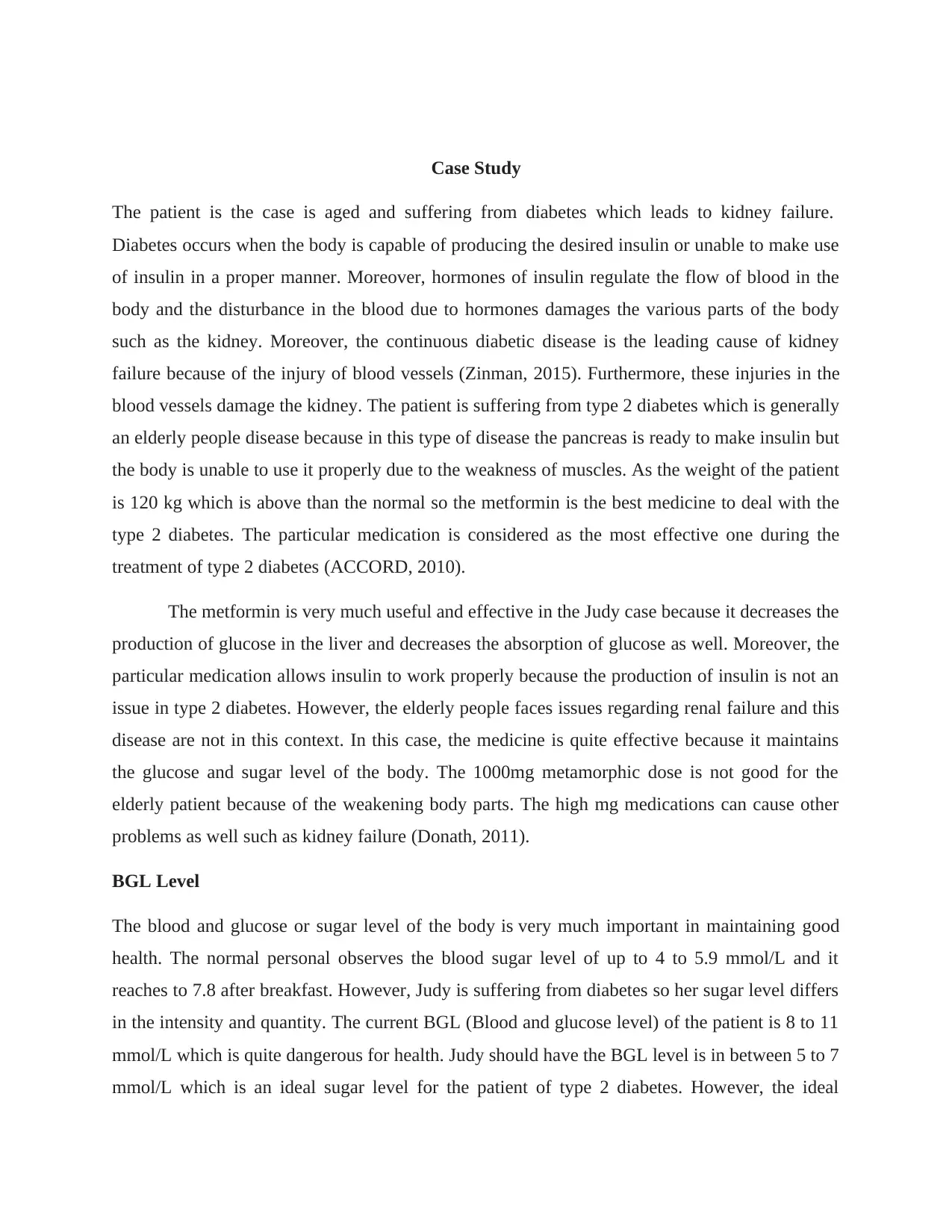
Case Study
The patient is the case is aged and suffering from diabetes which leads to kidney failure.
Diabetes occurs when the body is capable of producing the desired insulin or unable to make use
of insulin in a proper manner. Moreover, hormones of insulin regulate the flow of blood in the
body and the disturbance in the blood due to hormones damages the various parts of the body
such as the kidney. Moreover, the continuous diabetic disease is the leading cause of kidney
failure because of the injury of blood vessels (Zinman, 2015). Furthermore, these injuries in the
blood vessels damage the kidney. The patient is suffering from type 2 diabetes which is generally
an elderly people disease because in this type of disease the pancreas is ready to make insulin but
the body is unable to use it properly due to the weakness of muscles. As the weight of the patient
is 120 kg which is above than the normal so the metformin is the best medicine to deal with the
type 2 diabetes. The particular medication is considered as the most effective one during the
treatment of type 2 diabetes (ACCORD, 2010).
The metformin is very much useful and effective in the Judy case because it decreases the
production of glucose in the liver and decreases the absorption of glucose as well. Moreover, the
particular medication allows insulin to work properly because the production of insulin is not an
issue in type 2 diabetes. However, the elderly people faces issues regarding renal failure and this
disease are not in this context. In this case, the medicine is quite effective because it maintains
the glucose and sugar level of the body. The 1000mg metamorphic dose is not good for the
elderly patient because of the weakening body parts. The high mg medications can cause other
problems as well such as kidney failure (Donath, 2011).
BGL Level
The blood and glucose or sugar level of the body is very much important in maintaining good
health. The normal personal observes the blood sugar level of up to 4 to 5.9 mmol/L and it
reaches to 7.8 after breakfast. However, Judy is suffering from diabetes so her sugar level differs
in the intensity and quantity. The current BGL (Blood and glucose level) of the patient is 8 to 11
mmol/L which is quite dangerous for health. Judy should have the BGL level is in between 5 to 7
mmol/L which is an ideal sugar level for the patient of type 2 diabetes. However, the ideal
The patient is the case is aged and suffering from diabetes which leads to kidney failure.
Diabetes occurs when the body is capable of producing the desired insulin or unable to make use
of insulin in a proper manner. Moreover, hormones of insulin regulate the flow of blood in the
body and the disturbance in the blood due to hormones damages the various parts of the body
such as the kidney. Moreover, the continuous diabetic disease is the leading cause of kidney
failure because of the injury of blood vessels (Zinman, 2015). Furthermore, these injuries in the
blood vessels damage the kidney. The patient is suffering from type 2 diabetes which is generally
an elderly people disease because in this type of disease the pancreas is ready to make insulin but
the body is unable to use it properly due to the weakness of muscles. As the weight of the patient
is 120 kg which is above than the normal so the metformin is the best medicine to deal with the
type 2 diabetes. The particular medication is considered as the most effective one during the
treatment of type 2 diabetes (ACCORD, 2010).
The metformin is very much useful and effective in the Judy case because it decreases the
production of glucose in the liver and decreases the absorption of glucose as well. Moreover, the
particular medication allows insulin to work properly because the production of insulin is not an
issue in type 2 diabetes. However, the elderly people faces issues regarding renal failure and this
disease are not in this context. In this case, the medicine is quite effective because it maintains
the glucose and sugar level of the body. The 1000mg metamorphic dose is not good for the
elderly patient because of the weakening body parts. The high mg medications can cause other
problems as well such as kidney failure (Donath, 2011).
BGL Level
The blood and glucose or sugar level of the body is very much important in maintaining good
health. The normal personal observes the blood sugar level of up to 4 to 5.9 mmol/L and it
reaches to 7.8 after breakfast. However, Judy is suffering from diabetes so her sugar level differs
in the intensity and quantity. The current BGL (Blood and glucose level) of the patient is 8 to 11
mmol/L which is quite dangerous for health. Judy should have the BGL level is in between 5 to 7
mmol/L which is an ideal sugar level for the patient of type 2 diabetes. However, the ideal
Secure Best Marks with AI Grader
Need help grading? Try our AI Grader for instant feedback on your assignments.
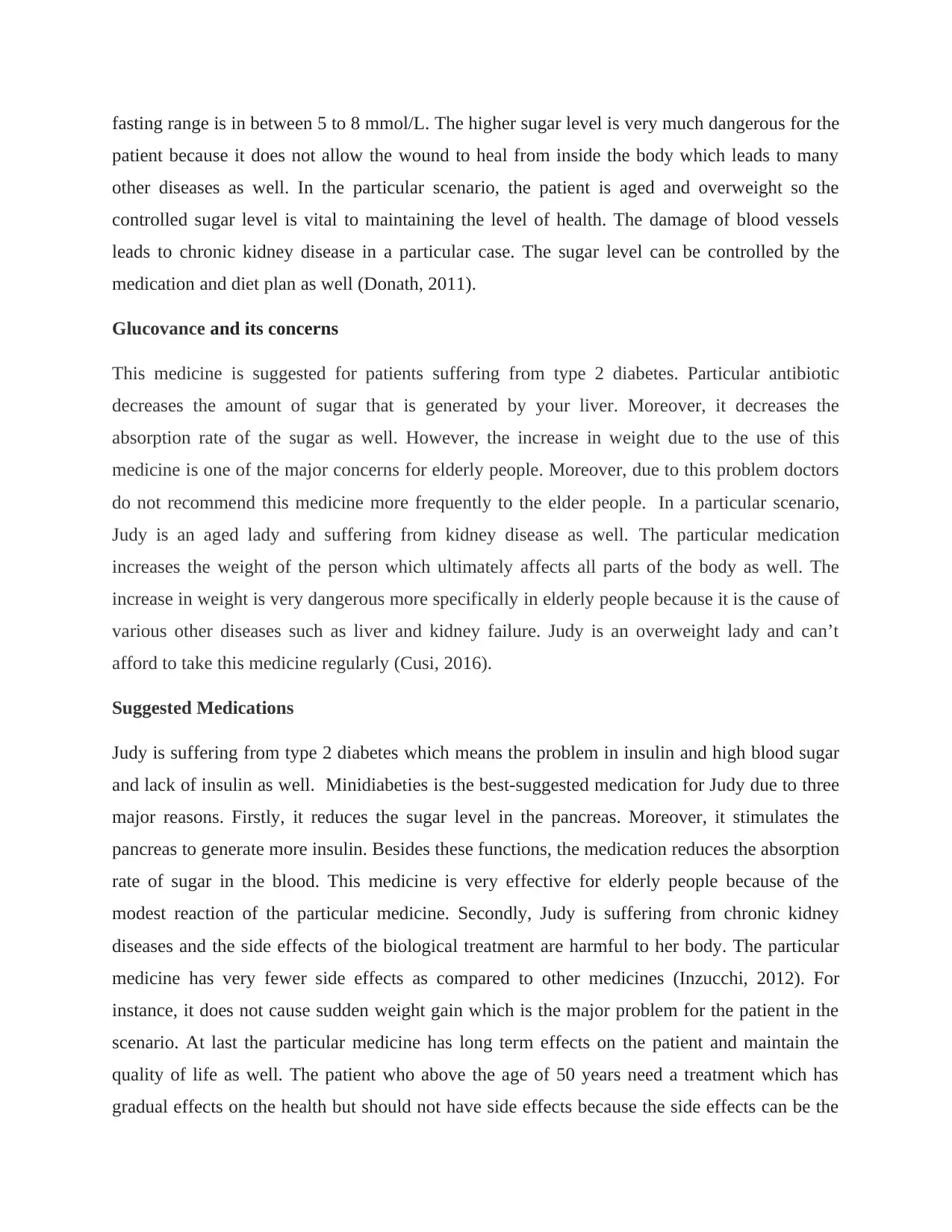
fasting range is in between 5 to 8 mmol/L. The higher sugar level is very much dangerous for the
patient because it does not allow the wound to heal from inside the body which leads to many
other diseases as well. In the particular scenario, the patient is aged and overweight so the
controlled sugar level is vital to maintaining the level of health. The damage of blood vessels
leads to chronic kidney disease in a particular case. The sugar level can be controlled by the
medication and diet plan as well (Donath, 2011).
Glucovance and its concerns
This medicine is suggested for patients suffering from type 2 diabetes. Particular antibiotic
decreases the amount of sugar that is generated by your liver. Moreover, it decreases the
absorption rate of the sugar as well. However, the increase in weight due to the use of this
medicine is one of the major concerns for elderly people. Moreover, due to this problem doctors
do not recommend this medicine more frequently to the elder people. In a particular scenario,
Judy is an aged lady and suffering from kidney disease as well. The particular medication
increases the weight of the person which ultimately affects all parts of the body as well. The
increase in weight is very dangerous more specifically in elderly people because it is the cause of
various other diseases such as liver and kidney failure. Judy is an overweight lady and can’t
afford to take this medicine regularly (Cusi, 2016).
Suggested Medications
Judy is suffering from type 2 diabetes which means the problem in insulin and high blood sugar
and lack of insulin as well. Minidiabeties is the best-suggested medication for Judy due to three
major reasons. Firstly, it reduces the sugar level in the pancreas. Moreover, it stimulates the
pancreas to generate more insulin. Besides these functions, the medication reduces the absorption
rate of sugar in the blood. This medicine is very effective for elderly people because of the
modest reaction of the particular medicine. Secondly, Judy is suffering from chronic kidney
diseases and the side effects of the biological treatment are harmful to her body. The particular
medicine has very fewer side effects as compared to other medicines (Inzucchi, 2012). For
instance, it does not cause sudden weight gain which is the major problem for the patient in the
scenario. At last the particular medicine has long term effects on the patient and maintain the
quality of life as well. The patient who above the age of 50 years need a treatment which has
gradual effects on the health but should not have side effects because the side effects can be the
patient because it does not allow the wound to heal from inside the body which leads to many
other diseases as well. In the particular scenario, the patient is aged and overweight so the
controlled sugar level is vital to maintaining the level of health. The damage of blood vessels
leads to chronic kidney disease in a particular case. The sugar level can be controlled by the
medication and diet plan as well (Donath, 2011).
Glucovance and its concerns
This medicine is suggested for patients suffering from type 2 diabetes. Particular antibiotic
decreases the amount of sugar that is generated by your liver. Moreover, it decreases the
absorption rate of the sugar as well. However, the increase in weight due to the use of this
medicine is one of the major concerns for elderly people. Moreover, due to this problem doctors
do not recommend this medicine more frequently to the elder people. In a particular scenario,
Judy is an aged lady and suffering from kidney disease as well. The particular medication
increases the weight of the person which ultimately affects all parts of the body as well. The
increase in weight is very dangerous more specifically in elderly people because it is the cause of
various other diseases such as liver and kidney failure. Judy is an overweight lady and can’t
afford to take this medicine regularly (Cusi, 2016).
Suggested Medications
Judy is suffering from type 2 diabetes which means the problem in insulin and high blood sugar
and lack of insulin as well. Minidiabeties is the best-suggested medication for Judy due to three
major reasons. Firstly, it reduces the sugar level in the pancreas. Moreover, it stimulates the
pancreas to generate more insulin. Besides these functions, the medication reduces the absorption
rate of sugar in the blood. This medicine is very effective for elderly people because of the
modest reaction of the particular medicine. Secondly, Judy is suffering from chronic kidney
diseases and the side effects of the biological treatment are harmful to her body. The particular
medicine has very fewer side effects as compared to other medicines (Inzucchi, 2012). For
instance, it does not cause sudden weight gain which is the major problem for the patient in the
scenario. At last the particular medicine has long term effects on the patient and maintain the
quality of life as well. The patient who above the age of 50 years need a treatment which has
gradual effects on the health but should not have side effects because the side effects can be the
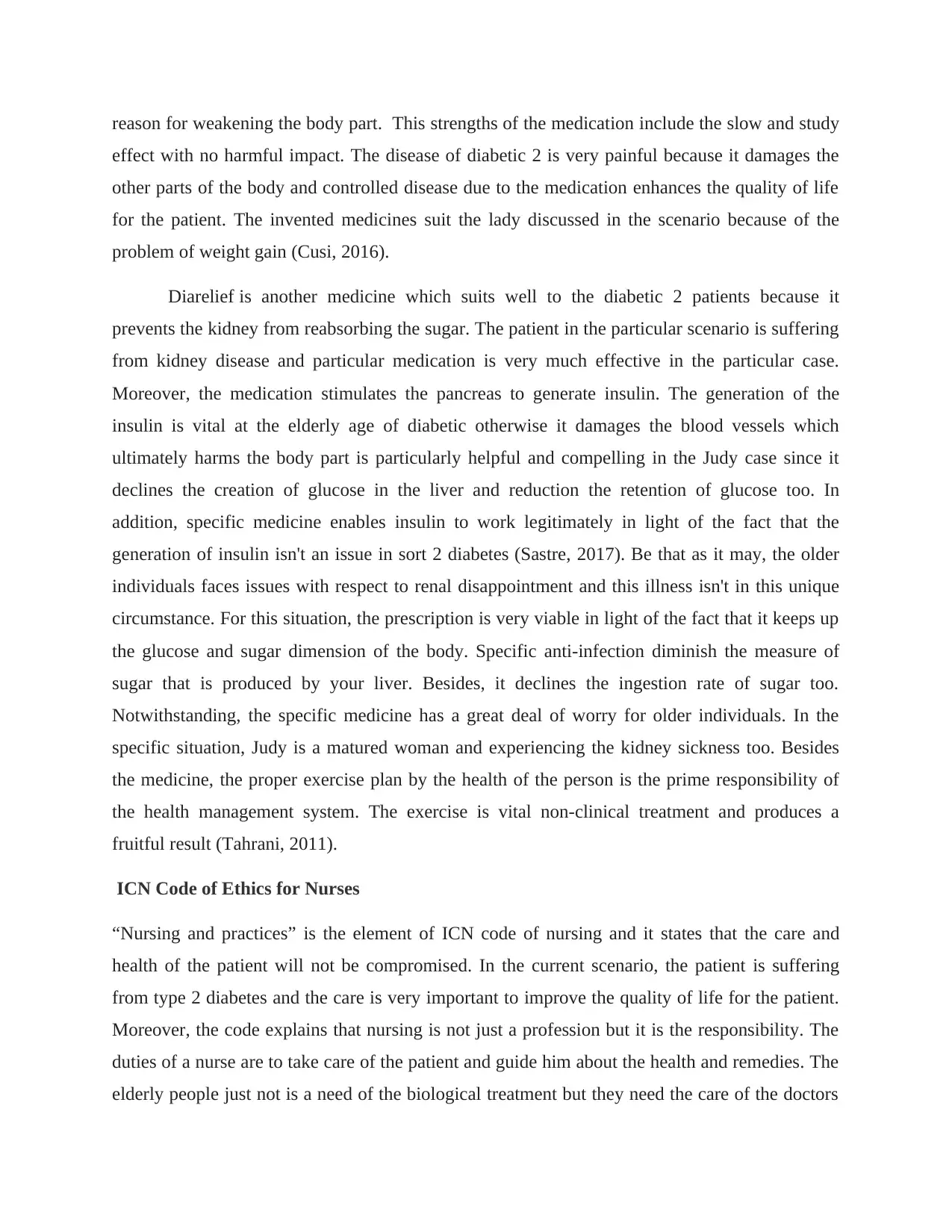
reason for weakening the body part. This strengths of the medication include the slow and study
effect with no harmful impact. The disease of diabetic 2 is very painful because it damages the
other parts of the body and controlled disease due to the medication enhances the quality of life
for the patient. The invented medicines suit the lady discussed in the scenario because of the
problem of weight gain (Cusi, 2016).
Diarelief is another medicine which suits well to the diabetic 2 patients because it
prevents the kidney from reabsorbing the sugar. The patient in the particular scenario is suffering
from kidney disease and particular medication is very much effective in the particular case.
Moreover, the medication stimulates the pancreas to generate insulin. The generation of the
insulin is vital at the elderly age of diabetic otherwise it damages the blood vessels which
ultimately harms the body part is particularly helpful and compelling in the Judy case since it
declines the creation of glucose in the liver and reduction the retention of glucose too. In
addition, specific medicine enables insulin to work legitimately in light of the fact that the
generation of insulin isn't an issue in sort 2 diabetes (Sastre, 2017). Be that as it may, the older
individuals faces issues with respect to renal disappointment and this illness isn't in this unique
circumstance. For this situation, the prescription is very viable in light of the fact that it keeps up
the glucose and sugar dimension of the body. Specific anti-infection diminish the measure of
sugar that is produced by your liver. Besides, it declines the ingestion rate of sugar too.
Notwithstanding, the specific medicine has a great deal of worry for older individuals. In the
specific situation, Judy is a matured woman and experiencing the kidney sickness too. Besides
the medicine, the proper exercise plan by the health of the person is the prime responsibility of
the health management system. The exercise is vital non-clinical treatment and produces a
fruitful result (Tahrani, 2011).
ICN Code of Ethics for Nurses
“Nursing and practices” is the element of ICN code of nursing and it states that the care and
health of the patient will not be compromised. In the current scenario, the patient is suffering
from type 2 diabetes and the care is very important to improve the quality of life for the patient.
Moreover, the code explains that nursing is not just a profession but it is the responsibility. The
duties of a nurse are to take care of the patient and guide him about the health and remedies. The
elderly people just not is a need of the biological treatment but they need the care of the doctors
effect with no harmful impact. The disease of diabetic 2 is very painful because it damages the
other parts of the body and controlled disease due to the medication enhances the quality of life
for the patient. The invented medicines suit the lady discussed in the scenario because of the
problem of weight gain (Cusi, 2016).
Diarelief is another medicine which suits well to the diabetic 2 patients because it
prevents the kidney from reabsorbing the sugar. The patient in the particular scenario is suffering
from kidney disease and particular medication is very much effective in the particular case.
Moreover, the medication stimulates the pancreas to generate insulin. The generation of the
insulin is vital at the elderly age of diabetic otherwise it damages the blood vessels which
ultimately harms the body part is particularly helpful and compelling in the Judy case since it
declines the creation of glucose in the liver and reduction the retention of glucose too. In
addition, specific medicine enables insulin to work legitimately in light of the fact that the
generation of insulin isn't an issue in sort 2 diabetes (Sastre, 2017). Be that as it may, the older
individuals faces issues with respect to renal disappointment and this illness isn't in this unique
circumstance. For this situation, the prescription is very viable in light of the fact that it keeps up
the glucose and sugar dimension of the body. Specific anti-infection diminish the measure of
sugar that is produced by your liver. Besides, it declines the ingestion rate of sugar too.
Notwithstanding, the specific medicine has a great deal of worry for older individuals. In the
specific situation, Judy is a matured woman and experiencing the kidney sickness too. Besides
the medicine, the proper exercise plan by the health of the person is the prime responsibility of
the health management system. The exercise is vital non-clinical treatment and produces a
fruitful result (Tahrani, 2011).
ICN Code of Ethics for Nurses
“Nursing and practices” is the element of ICN code of nursing and it states that the care and
health of the patient will not be compromised. In the current scenario, the patient is suffering
from type 2 diabetes and the care is very important to improve the quality of life for the patient.
Moreover, the code explains that nursing is not just a profession but it is the responsibility. The
duties of a nurse are to take care of the patient and guide him about the health and remedies. The
elderly people just not is a need of the biological treatment but they need the care of the doctors
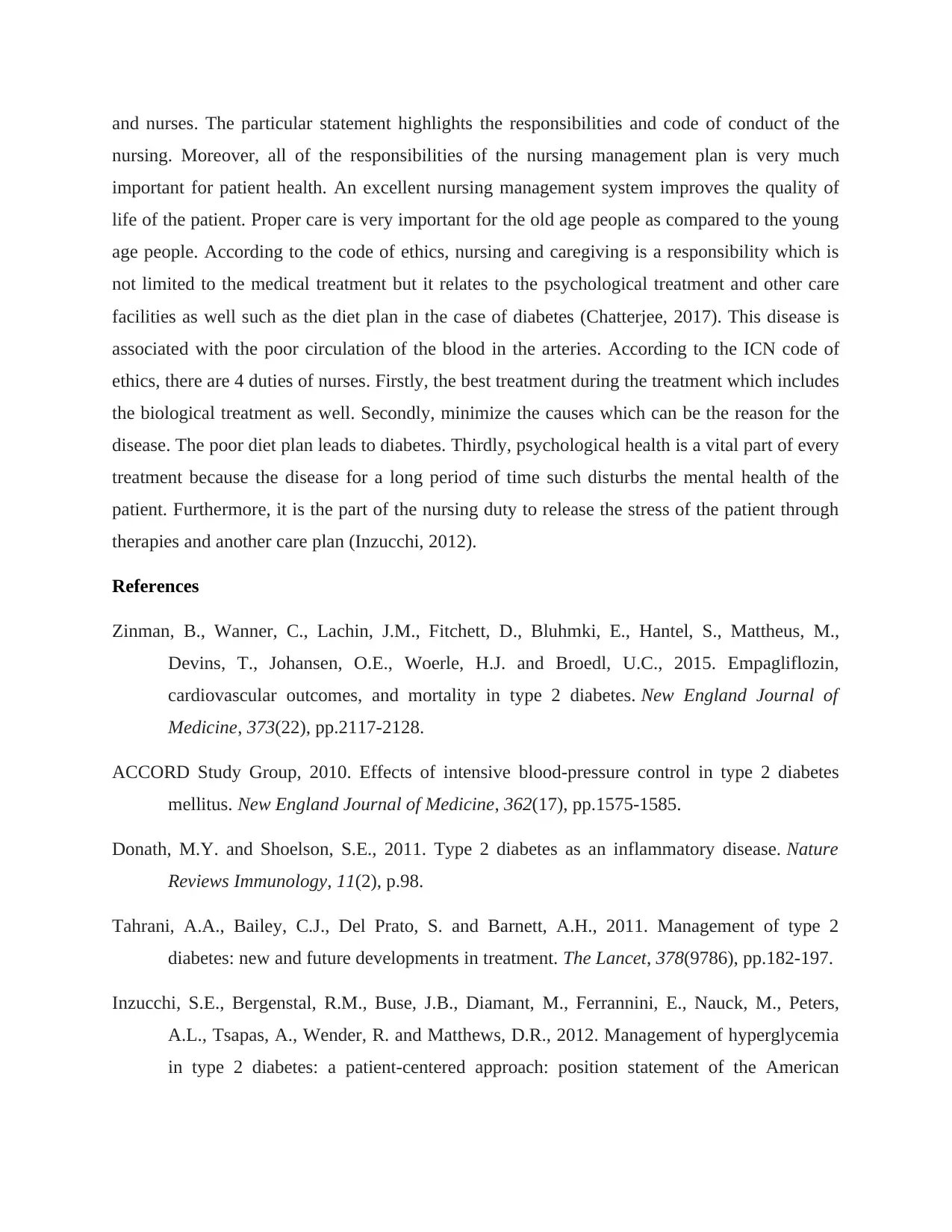
and nurses. The particular statement highlights the responsibilities and code of conduct of the
nursing. Moreover, all of the responsibilities of the nursing management plan is very much
important for patient health. An excellent nursing management system improves the quality of
life of the patient. Proper care is very important for the old age people as compared to the young
age people. According to the code of ethics, nursing and caregiving is a responsibility which is
not limited to the medical treatment but it relates to the psychological treatment and other care
facilities as well such as the diet plan in the case of diabetes (Chatterjee, 2017). This disease is
associated with the poor circulation of the blood in the arteries. According to the ICN code of
ethics, there are 4 duties of nurses. Firstly, the best treatment during the treatment which includes
the biological treatment as well. Secondly, minimize the causes which can be the reason for the
disease. The poor diet plan leads to diabetes. Thirdly, psychological health is a vital part of every
treatment because the disease for a long period of time such disturbs the mental health of the
patient. Furthermore, it is the part of the nursing duty to release the stress of the patient through
therapies and another care plan (Inzucchi, 2012).
References
Zinman, B., Wanner, C., Lachin, J.M., Fitchett, D., Bluhmki, E., Hantel, S., Mattheus, M.,
Devins, T., Johansen, O.E., Woerle, H.J. and Broedl, U.C., 2015. Empagliflozin,
cardiovascular outcomes, and mortality in type 2 diabetes. New England Journal of
Medicine, 373(22), pp.2117-2128.
ACCORD Study Group, 2010. Effects of intensive blood-pressure control in type 2 diabetes
mellitus. New England Journal of Medicine, 362(17), pp.1575-1585.
Donath, M.Y. and Shoelson, S.E., 2011. Type 2 diabetes as an inflammatory disease. Nature
Reviews Immunology, 11(2), p.98.
Tahrani, A.A., Bailey, C.J., Del Prato, S. and Barnett, A.H., 2011. Management of type 2
diabetes: new and future developments in treatment. The Lancet, 378(9786), pp.182-197.
Inzucchi, S.E., Bergenstal, R.M., Buse, J.B., Diamant, M., Ferrannini, E., Nauck, M., Peters,
A.L., Tsapas, A., Wender, R. and Matthews, D.R., 2012. Management of hyperglycemia
in type 2 diabetes: a patient-centered approach: position statement of the American
nursing. Moreover, all of the responsibilities of the nursing management plan is very much
important for patient health. An excellent nursing management system improves the quality of
life of the patient. Proper care is very important for the old age people as compared to the young
age people. According to the code of ethics, nursing and caregiving is a responsibility which is
not limited to the medical treatment but it relates to the psychological treatment and other care
facilities as well such as the diet plan in the case of diabetes (Chatterjee, 2017). This disease is
associated with the poor circulation of the blood in the arteries. According to the ICN code of
ethics, there are 4 duties of nurses. Firstly, the best treatment during the treatment which includes
the biological treatment as well. Secondly, minimize the causes which can be the reason for the
disease. The poor diet plan leads to diabetes. Thirdly, psychological health is a vital part of every
treatment because the disease for a long period of time such disturbs the mental health of the
patient. Furthermore, it is the part of the nursing duty to release the stress of the patient through
therapies and another care plan (Inzucchi, 2012).
References
Zinman, B., Wanner, C., Lachin, J.M., Fitchett, D., Bluhmki, E., Hantel, S., Mattheus, M.,
Devins, T., Johansen, O.E., Woerle, H.J. and Broedl, U.C., 2015. Empagliflozin,
cardiovascular outcomes, and mortality in type 2 diabetes. New England Journal of
Medicine, 373(22), pp.2117-2128.
ACCORD Study Group, 2010. Effects of intensive blood-pressure control in type 2 diabetes
mellitus. New England Journal of Medicine, 362(17), pp.1575-1585.
Donath, M.Y. and Shoelson, S.E., 2011. Type 2 diabetes as an inflammatory disease. Nature
Reviews Immunology, 11(2), p.98.
Tahrani, A.A., Bailey, C.J., Del Prato, S. and Barnett, A.H., 2011. Management of type 2
diabetes: new and future developments in treatment. The Lancet, 378(9786), pp.182-197.
Inzucchi, S.E., Bergenstal, R.M., Buse, J.B., Diamant, M., Ferrannini, E., Nauck, M., Peters,
A.L., Tsapas, A., Wender, R. and Matthews, D.R., 2012. Management of hyperglycemia
in type 2 diabetes: a patient-centered approach: position statement of the American
Paraphrase This Document
Need a fresh take? Get an instant paraphrase of this document with our AI Paraphraser
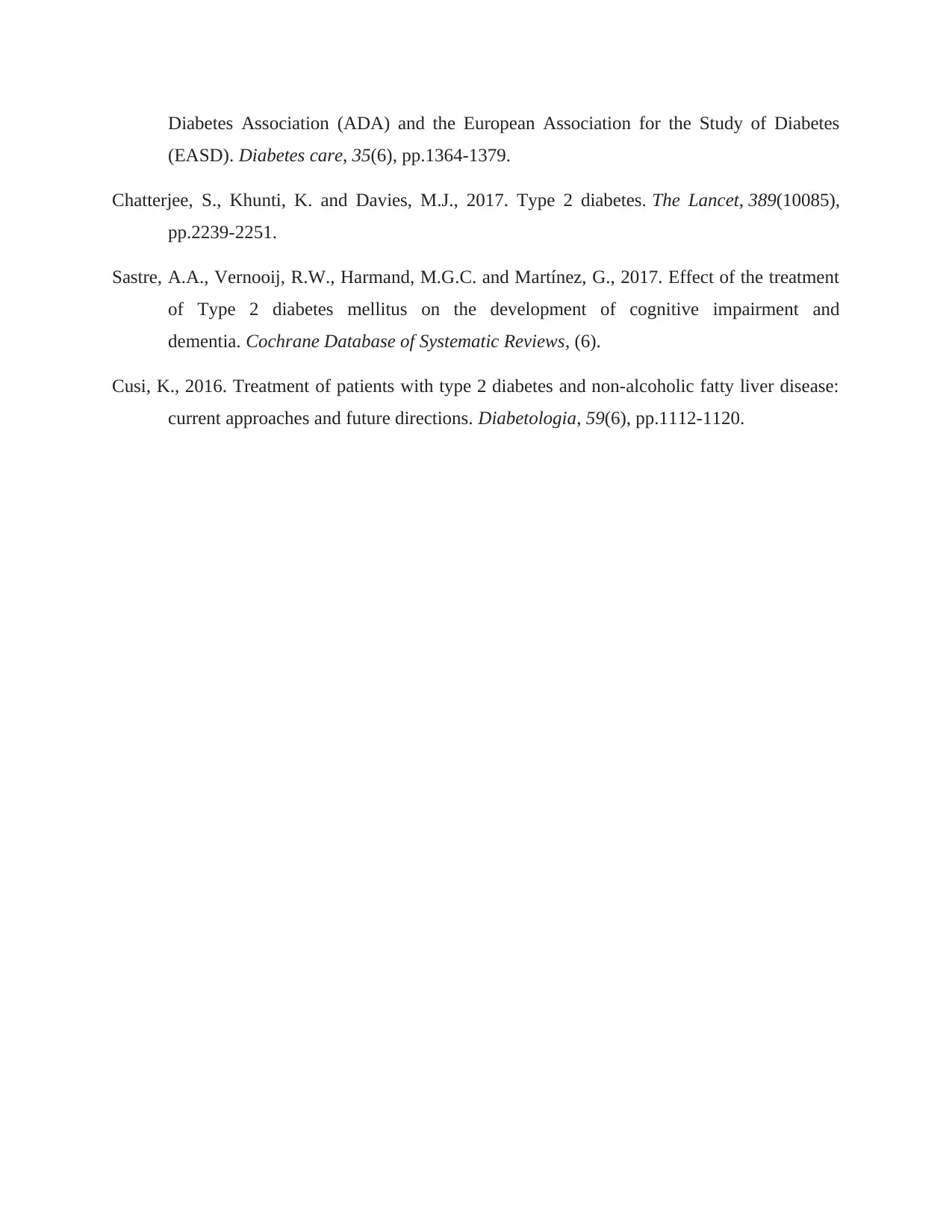
Diabetes Association (ADA) and the European Association for the Study of Diabetes
(EASD). Diabetes care, 35(6), pp.1364-1379.
Chatterjee, S., Khunti, K. and Davies, M.J., 2017. Type 2 diabetes. The Lancet, 389(10085),
pp.2239-2251.
Sastre, A.A., Vernooij, R.W., Harmand, M.G.C. and Martínez, G., 2017. Effect of the treatment
of Type 2 diabetes mellitus on the development of cognitive impairment and
dementia. Cochrane Database of Systematic Reviews, (6).
Cusi, K., 2016. Treatment of patients with type 2 diabetes and non-alcoholic fatty liver disease:
current approaches and future directions. Diabetologia, 59(6), pp.1112-1120.
(EASD). Diabetes care, 35(6), pp.1364-1379.
Chatterjee, S., Khunti, K. and Davies, M.J., 2017. Type 2 diabetes. The Lancet, 389(10085),
pp.2239-2251.
Sastre, A.A., Vernooij, R.W., Harmand, M.G.C. and Martínez, G., 2017. Effect of the treatment
of Type 2 diabetes mellitus on the development of cognitive impairment and
dementia. Cochrane Database of Systematic Reviews, (6).
Cusi, K., 2016. Treatment of patients with type 2 diabetes and non-alcoholic fatty liver disease:
current approaches and future directions. Diabetologia, 59(6), pp.1112-1120.
1 out of 5
Related Documents
Your All-in-One AI-Powered Toolkit for Academic Success.
+13062052269
info@desklib.com
Available 24*7 on WhatsApp / Email
![[object Object]](/_next/static/media/star-bottom.7253800d.svg)
Unlock your academic potential
© 2024 | Zucol Services PVT LTD | All rights reserved.





